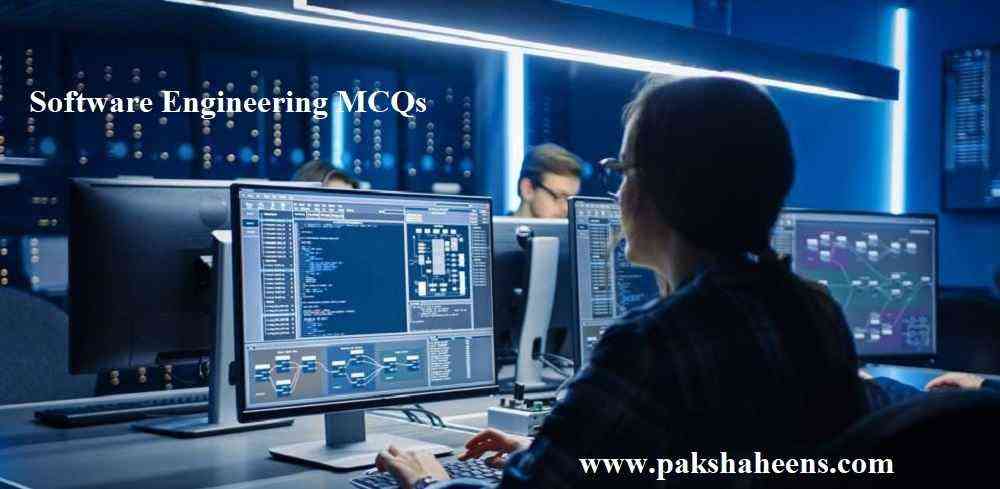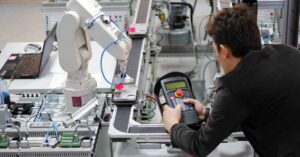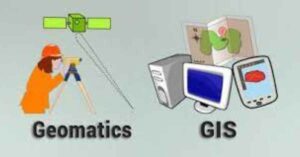
Software Engineering MCQs
Software Engineering MCQs are given here which are very beneficial for the initial tests of Army Lady Cadet Course, PAF Engineering branch, Navy Engineering/ Operational branch, Direct Short Service Commission and PAF Aeronautical Branch.
If you want to join Pak Army, Pak navy and Pakistan Air Force (PAF) then Multiple Choice Questions of Software Engineering are past experience of the students who appeared in different tests.
Software Engineering MCQs Test Online
Software Engineering MCQs (Part-01)
What is the first step in the software development lifecycle?
- System Design
- Coding
- System Testing
- Preliminary Investigation and Analysis
Answer: d)
What does the study of an existing system refer to?
- Details of DFD
- Feasibility Study
- System Analysis
- System Planning
Answer: c)
- Sizing
- Parallel run
- Specification freeze
- All of the above
Answer: d)
What does RAD stand for?
- Rapid Application Document
- Rapid Application Development
- Relative Application Development
- None of the above
Answer: b)
Which of the following prototypes does not associated with Prototyping Model?
- Domain Prototype
- Vertical Prototype
- Horizontal Prototype
- Diagonal Prototype
Answer: d)
The major drawback of RAD model is __________.
- It requires highly skilled developers/designers.
- It necessitates customer feedbacks.
- It increases the component reusability.
- Both (a) & (c)
Answer: d)
Which of the following does not relate to Evolutionary Process Model?
- Incremental Model
- Concurrent Development Model
- WINWIN Spiral Model
- All of the above
Answer: d)
What is the major drawback of the Spiral Model?
- Higher amount of risk analysis
- Doesn’t work well for smaller projects
- Additional functionalities are added later on
- Strong approval and documentation control
Answer: b)
Model selection is based on __________.
- Requirements
- Development team & users
- Project type & associated risk
- All of the above
Answer: d)
Check also: Join Pak Army as a Lady Officer through LCC
Software Engineering MCQs PDF
Software Engineering MCQs (Part-02)
Which of the following option is correct?
- The prototyping model facilitates the reusability of components.
- RAD Model facilitates reusability of components
- Both RAD & Prototyping Model facilitates reusability of components
- None
Answer: c)
- RAD & Waterfall
- Prototyping & Waterfall
- Spiral & Prototyping
- Spiral & RAD
Answer: c)
- Prototyping & Waterfall
- Prototyping & RAD
- Prototyping & Spiral
- RAD & Spiral
Answer: b)
- Spiral
- Iterative Enhancement
- RAD
- Both (b) and (c)
Answer: d)
Arrange the following activities for making a software product by utilizing 4GT.
- Design strategy
- Transformation into product
- Implementation
- Requirement gathering
- 4, 1, 3, 2
- 4, 3, 2, 1
- 1, 2, 3, 4
- 1, 4, 2, 3
Answer: a)
Which of the following is an example of Black Box and Functional Processing?
- First Generation Language
- Second Generation Language
- Third Generation Language
- Fourth Generation Language
Answer: d)
__________ is identified as fourth generation language.
- Unix shell
- C++
- COBOL
- FORTRAN
Answer: a)
The productivity of a software engineer can be reduced by using a 4GT.
- True
- False
Answer: b)
- The productivity of software engineers is improved.
- The time required for developing software is reduced.
- CASE tools and code generators help the 4GT model by providing a credible solution to their problems.
- None of the above.
Answer: b)
- 4GT Model
- Waterfall Model
- RAD Model
- Spiral Model
Answer: a)
Check also: Check your Weight as Per Height for Pak Forces
Software Engineering MCQs for Entry Test
Software Engineering MCQs (Part-03)
Which of the following falls under the category of software products?
- Firmware, CAD
- Embedded, CAM
- Customized, Generic
- CAD, Embedded
Answer: c)
Software maintenance costs are expensive in contrast to software development.
- True
- False
Answer: a)
Which of the following activities of the generic process framework delivers a feedback report?
- Deployment
- Planning
- Modeling
- Construction
Answer: a)
Which of the following refers to internal software equality?
- Scalability
- Reusability
- Reliability
- Usability
Answer: b)
RUP is abbreviated as __________, invented by a division of __________.
- Rational Unified Process, IBM
- Rational Unified Program, IBM
- Rational Unified Process, Infosys
- Rational Unified Program, Infosys
Answer: a)
- It recommends some good practices that be included while carrying out the process.
- It displays all the enacted process activities.
- It portrays the phases that the model has entered over a specific time.
- All of the above.
Answer: b)
- Software Evolution
- Software Verification
- Software Testing & Validation
- Software designing
Answer: b)
Arrange the following activities to form a general software engineering process model.
- Manufacture
- Maintain
- Test
- Install
- Design
- Specification
- 6, 5, 1, 3, 4, 2
- 1, 2, 4, 3, 6, 5
- 6, 1, 4, 2, 3, 5
- 1, 6, 5, 2, 3, 4
Answer: a)
The agile software development model is built based on __________.
- Linear Development
- Incremental Development
- Iterative Development
- Both Incremental and Iterative Development
Answer: d)
Check also: Past Interview Questions
Software Engineering MCQs Interview Questions
Software Engineering MCQs (Part-04)
On what basis is plan-driven development different from that of the software development process?
- Based on the iterations that occurred within the activities.
- Based on the output, which is derived after negotiating in the software development process.
- Based on the interleaved specification, design, testing, and implementation activities.
- All of the above
Answer: a)
Which of the following activities is not applicable to agile software development?
- Producing only the essential work products.
- Utilizing the strategy of incremental product delivery.
- Abolishing the project planning and testing.
- All of the above
Answer: c)
Which of the following framework activities are carried out in Adaptive Software Development (ASD)?
- Assumption, Association, Learning
- The investigation, Strategy, Coding
- Requirements gathering, Adaptive cycle planning, Iterative development
- All of the above
Answer: a)
The __________ model helps in representing the system’s dynamic behavior.
- Object Model
- Context Model
- Behavioral Model
- Data Model
Answer: c)
- True
- False
Answer: b)
The __________ and __________ are the two major dimensions encompassed in the Spiral model.
- Diagonal, Perpendicular
- Perpendicular, Radial
- Angular, diagonal
- Radial, Angular
Answer: d)
- Reengineering
- Forward engineering
- Reverse engineering
- Reverse engineering and Reengineering
Answer: d)
An erroneous system state that results in an unexpected system behavior is acknowledged as?
- System failure
- Human error or mistake
- System error
- System fault
Answer: c)
What is the name of the approach that follows step-by-step instructions for solving a problem?
- An Algorithm
- A Plan
- A List
- Sequential Structure
Answer: a)
Which of the following word correctly summarized the importance of software design?
- Quality
- Complexity
- Efficiency
- Accuracy
Answer: a)
Check also: How to increase Height after 21 years?
Software Engineering MCQs Free Download
Software Engineering MCQs (Part-05)
Which of the following methodology results in SA/SD features?
- Gane and Sarson methodology
- DeMarco and Yourdon methodology
- Constantine and Yourdon methodology
- All of the above
Answer: d)
__________ is not considered as an activity of Structured Analysis (SA).
- Transformation of a textual problem description into a graphic model
- Functional decomposition
- All the functions represented in the DFD are mapped to a module structure
- All of the mentioned
Answer: c
What does a directed arc or line signify?
- Data Flow
- Data Process
- Data Stores
- None of the above
Answer: a)
What does a data store symbol in the Data Flow Diagram signify?
- Logical File
- Physical File
- Data Structure
- All of the above
Answer: d)
__________ is not a direct measure of SE process.
- Effort
- Cost
- Efficiency
- All of the above
Answer: c)
What is the main task of project indicators?
- To evaluate the ongoing project’s status and track possible risks.
- To evaluate the ongoing project’s status.
- To track potential risks.
- None of the above
Answer: a)
What is the main intent of project metrics?
- For strategic purposes
- To minimize the development schedule.
- To evaluate the ongoing project’s quality on a daily basis
- To minimize the development schedule and evaluate the ongoing project’s quality on a daily basis
Answer: d)
Name the graphical practice that depicts the meaningful changes that occurred in metrics data.
- Function point analysis
- Control Chart
- DRE (Defect Removal Efficiency)
- None of the above
Answer: c)
Which parameters are essentially used while computing the software development cost?
- Hardware and Software Costs
- Effort Costs
- Travel and Training Costs
- All of the above
Answer: d)
- Change management
- System management
- Internship management
- Version management
Answer: c)
Check also: Best Exercises for Knee Knocking Issue
Software Engineering Solved MCQs PDF
Software Engineering MCQs (Part-06)
- Planning process
- Decomposition
- Association
- All of the mentioned
Answer: b)
- The ability to translate the size estimate into human effort, calendar time, and dollars
- Use relatively simple decomposition techniques to generate project cost and effort estimates.
- Base estimates on similar projects that have already been completed
- Use one or more empirical models for software cost and effort estimation
Answer: a)
- Empirical estimation models
- Decomposition techniques
- Automated estimation tools
- Both empirical estimation models and automated estimation tools
Answer: a)
Which of the following is not included in the total effort cost?
- Costs of lunch time food
- Costs of support staff
- Costs of networking and communications
- Costs of air conditioning and lighting in the office space
Answer: a)
What is developed by utilizing the historical cost function?
- Parkinson’s Law
- Expert judgment
- Algorithmic cost modeling
- Estimation by analogy
Answer: c)
- The reuse model
- An early designed model
- An application-composition model
- A post architecture model
Answer: c)
Which of the following is used to predict the effort as a function of LOC or FP?
- COCOMO
- FP-based estimation
- Both COCOMO and FP-based estimation
- Process-based estimation
Answer: c)
- Application composition model
- Post-architecture-stage model
- Early design stage model
- All of the above
Answer: a)
Which of the following threatens the quality and timeliness of the produced software?
- Business risks
- Potential risks
- Technical risks
- Known risks
Answer: c)
- Performance risk
- Risk identification
- Risk projection
- Support risk
Answer: c)
Which of the following standards is used by the aviation industry?
- CTRADO-172B
- RTCADO-178B
- RTRADO-178B
- CTCADO-178B
Answer: b)
Third-Party Certification for software standards is based on __________.
- Ul 1996, Second Edition
- Ul 1998, Second Edition
- Ul 1992, Second Edition
- UT 1998, Second Edition
Answer: b)





